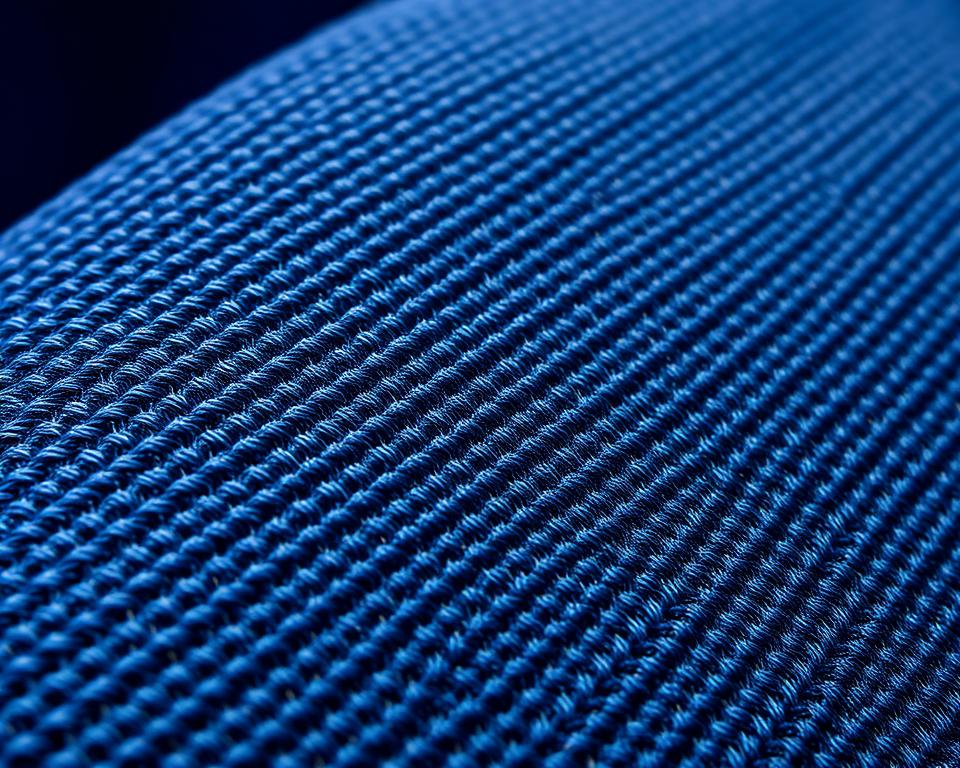The Ultimate Primer on Selvedge Denim Material
One solitary set of antique Levi’s 501s hailing from the 1940s fetched $87,400 at an auction. What made these jeans worth more than a luxury car? It all comes down to their selvedge denim fabrication.
This top-tier denim signifies far more than mere cloth. It connects us to a time when James Dean wore his 501s in Rebel Without a Cause and Marlon Brando defined cool in The Wild One. These cultural icons didn’t just wear jeans. They sported selvedge denim fabric made on historic shuttle looms.
Craft denim derives its title from the self-finished perimeters that avert fraying. The term “selvedge” combines “self” and “edge” to describe this unique weaving method. Unlike mass-produced jeans, each yard of selvedge denim material takes time and skill to create.
The surface narrates a tale via gentle inconsistencies and organic variations. Each pair develops its own character as the indigo fades. This unique aging grants heritage denim its special appeal among collectors and fashion devotees alike.
Numerous people assume high-end denim endures beyond ordinary jeans. The reality, however, is more delicate. Selvedge construction creates beautiful fabric with clean edges and rich texture. However, sturdiness relies on cotton caliber and heft, not merely on weaving style. What differentiates artisanal denim is its knack for aging with grace and creating singular fading designs in the long run.
What Is Selvedge Denim Material
Selvedge denim textile differs from common denim on account of its exclusive construction and self-finished edges. It’s titled after its “self-edge,” a closely woven strip that blocks fraying. This top-tier fabric embodies a commitment to slow fashion and classic artisanry, distinguishing it from factory-produced denim.

The Meaning Behind Self-Edge Construction
“Selvedge” mixes “self” and “edge,” depicting cloth with a neat, complete border. This narrow selvage appears on both sides of the fabric, doing away with extra finishing. Traditional mills produce it in widths of about 30-32 inches, unlike modern denim’s 60-inch width.
Why Shuttle Looms Yield Distinct Fabric Edges
Denim from shuttle looms derives its persona from antique weaving machines running at reduced speeds. These looms weave a single weft yarn across the warp threads in one motion. This approach produces:
- Organic textural slubs
- A gentler hand-feel compared to contemporary denim
- Tightly bound edges that won’t fray
- Real irregular traits loved by denim aficionados
How Selvedge Differs from Standard Denim
Regular denim comes from projectile looms firing weft yarns over broader widths. This method leaves loose threads at the edges, needing overlocked seams to prevent fraying. Selvedge denim fabric, on the other hand, takes more time to produce. It delivers enhanced durability and a distinct look, warranting its premium price.
The Heritage and History of Shuttle-Loomed Denim
The journey of heritage denim started in American textile mills in the 1800s. Shuttle looms played a vital role, crafting cloth with self-finished edges to stop fraying. This practice created indigo-dyed denim deliberately and meticulously, ensuring every yard was built with attention to detail. Its slender width evolved into a trademark of artisan denim manufacture.
From 1800s American Mills to Modern Revival
For more than 100 years, U.S. mills depended on shuttle looms. Brands like Cone Mills and White Oak supplied premium denim to workwear companies. By the 1970s, quick projectile looms dominated, displacing most shuttle machines. This shift was driven by the need for cheaper, mass-produced jeans. Many historic mills closed or modernized, leaving vintage looms to gather dust.
How Japan Revived Selvedge Denim
In the 1980s, Japanese producers brought American shuttle looms back into use. The Osaka Five labels headed this resurgence:
- Studio D’Artisan
- Evisu
- Fullcount
- Warehouse
- Denime
They combined American heritage style and Japanese meticulousness. They examined vintage Levi’s patterns and reimagined time-honored indigo-dyed denim feels. By 2000, Japanese makers had overtaken the global artisan denim market.
Why Old-School Weaving Techniques Matter Today
Shuttle looms yield distinct cloth traits that contemporary machines cannot replicate. The slower weaving process allows for irregular textures and deeper indigo penetration. Premium denim enthusiasts cherish these imperfections as signs of authentic craftsmanship.
| Shuttle Loom Features | Modern Loom Features |
|---|---|
| 29-31 inch fabric width | 60+ inch fabric width |
| 3-4 yards per hour | 15-20 yards per hour |
| Natural irregularities | Uniform texture |
| Self-finished edges | Cut edges requiring overlocking |
Making Premium Denim on Antique Looms
The birth of premium denim begins with shuttle looms’ measured cadence. These machines differ from today’s technology. They shuttle yarn across the full width at once, binding edges without further work. This method ensures selvedge denim has a clean, non-fraying edge.
Antique looms run slowly, churning out only 5–6 meters of slub denim per day. This sharply contrasts with current machines that manage 200 meters. The slower speed benefits the yarn in several ways:
- Reduced fiber tension yields a gentler feel
- Inherent slubs persist, offering a one-of-a-kind texture
- Varied surfaces produce signature fading
- Thin widths (about 29–32 inches) minimize trimming waste
Manning these age-old looms calls for seasoned artisans. Mill workers adjust tension, monitor rhythm, and perform repairs. Each loom has its own unique character. Several originate from the 1920s and rely on skills handed down over decades. This tactile method turns shuttle-loomed denim into an authentic artisan good.
The narrow width of dry denim from vintage looms has a practical benefit. Denim craftsmen can employ the finished edge as the outseam, cutting waste. This highlights the material’s genuine build. Every roll has its own story, with subtle variations that mass production can’t replicate.
Understanding Raw Denim vs Selvedge Differences
A lot of denim fans mix up raw denim and selvedge denim. This mix-up appears during premium jean hunts. The truth is, these terms describe different aspects of denim production. Knowing the difference helps you make better choices and appreciate each type’s uniqueness.
Why Selvedge Doesn’t Always Mean Raw
Selvedge indicates the shuttle-loom weave that forms self-finished borders. Raw denim stands for unwashed textile direct from production. A selvedge raw denim distributor often carries both rinse and dry options. Labels such as Naked & Famous make selvedge jeans, occasionally pre-rinsed or with elastane.
The loom process stays constant. However, finishing transforms both the cloth’s texture and appearance.
Washed vs Unwashed Denim Options
Each denim item originates as dry denim before laundering. Mills produce both standard and selvedge versions unwashed. Key contrasts include:
- Raw denim evolves custom fade patterns via use
- Washed denim delivers immediate softness and size consistency
- Sanforized raw shrinks minimally post-first wash
- Unsanforized cloth contracts substantially when wet
Clearing Up Denim Myths
Not all raw denim comes from shuttle looms. Contemporary projectile looms likewise churn out unwashed textile. Their appeal converges since consumers prize longevity, customization, and artistry in both selvedge and raw denim. Both types attract denim heads willing to invest time for that perfect custom fade.
Identifying Authentic Selvedge Denim Features
When hunting for selvadge raw denim fabric wholesaler, identifying authentic selvedge denim is crucial. It distinguishes you from casual shoppers. Genuine selvedge denim boasts characteristics missing in standard denim. Knowing these signs guarantees you’re buying true high-end denim.
Spotting the Signature Selvedge ID
Easiest method to confirm selvedge denim? Inspect the outseam. Roll your cuffs and examine the seam on the leg’s outer side. Genuine selvedge denim has a clean, finished edge with colored yarns woven into the fabric. That self-finished border removes the necessity for overlock stitching typical in normal denim.
When you cuff your jeans, the selvedge ID becomes visible, adding a unique touch to your style. The colored edge yarns run continuously down the outseam, creating that signature look denim enthusiasts adore. Non-selvedge jeans, on the other hand, have cut edges covered with serger stitching to prevent fraying.
Quality Construction Hallmarks
Quality premium denim is evident through several construction details:
- Compact, consistent weave without loose fibers
- Neat selvedge borders lacking extra seams
- Stable colored yarn running the full outseam
- Heavy fabric weight characteristic of shuttle looms
Rainbow vs Redline Selvedge Distinctions
Rainbow selvedge denim features multiple colored yarns in the selvedge ID, creating a unique multicolor edge. Redline selvedge, the most famous variety, uses red yarns for the ID and traces back to vintage American mills. These distinctive selvedge variants fetch more owing to their rarity and visual charm. Many labels emphasize these traits in their descriptions, simplifying the hunt for real heritage denim.
What Drives Artisanal Denim Prices
The price of artisanal denim frequently surprises first-timers. Selvedge jeans often cost 3–5× more than factory-made pairs.
Comprehending what drives these costs shows the actual value of premium denim.
Shuttle looms operate at a far slower rate than modern counterparts. Though factory looms crank out fabric fast, old shuttle looms manage only 1–2 meters hourly. That unhurried pace means crafting a bolt of heritage denim spans days, not hours.
The slender breadth of selvedge fabric hikes up costs. Whereas conventional denim comes 60 inches wide, shuttle-loomed premium denim measures only 28–32 inches. This restricted width entails meticulous layout and cutting to minimize waste.
Artisan denim is produced in limited lots. Firms such as Okayama’s White Oak and Kuroki favor excellence over volume. They rely on veteran craftsmen who supervise every phase:
- Hand-checking yarn tension
- Adjusting loom settings for each fabric type
- Inspecting every meter for flaws
- Managing rope-dyeing processes that take weeks
These artisans treat denim-making like fine art. They experiment with unique yarns and perfect indigo-dyeing recipes passed down through generations. Backing heritage denim helps mills safeguard textile legacies and artisans devoted to their work.
Where to Buy Black Selvedge Denim Fabric Wholesale
The premium denim market has grown beyond Japan’s traditional mills. American brands now compete, providing a wide range of black selvedge denim fabric wholesale. Finding top suppliers means knowing quality indicators and authentic fabric sources.
Finding Quality Suppliers and Manufacturers
Premium suppliers highlight classic weaving and heartfelt commitment to artistry. Hunting for a selvedge raw denim wholesaler? Seek out mills still running shuttle looms. They provide comprehensive fabric details: weight, weave style, and dye processes.
Key Gold Selvedge Denim Producers
Gold selvedge denim fabric manufacturers focus on premium colored ID lines, adding luxury to jeans. Top factories craft these niche fabrics in small batches, drawing boutique labels. Their gold-edge thread grants a distinctive finish, setting them apart from common fabrics.
Sourcing Specialty Fabrics Like Nep Denim
Special weaves like nep denim warrant direct sourcing links. Nep denim boasts purposeful slubs for eye-catching texture. Directly working with mills ensures access to these specialized weaves.
| Fabric Type | Minimum Order | Lead Time | Price Range per Yard |
|---|---|---|---|
| Black Selvedge | 500 yards | 6-8 weeks | $12-18 |
| Gold ID Selvedge | 300 yards | 8-10 weeks | $15-22 |
| Nep Denim | 400 yards | 10-12 weeks | $14-20 |
Top Selvedge Styles & Variations
Selvedge denim circles stretch beyond simple indigo. Now, suppliers craft diverse textures and motifs. These showcase the versatility of shuttle loom weaving. From subtle surface variations to bold visual patterns, these fabrics offer unique character that develops beautifully with wear.
All About Slub Denim Texture
Slub denim’s distinctive bumpy texture comes from irregular yarns. They include thick and slim sections, producing an inherently varied cloth surface. Woven on shuttle looms, they form slub-textured selvedge that fades unpredictably.
Every slub denim pair evolves a distinct fade motif. The raised slubs fade differently than the flat parts, ensuring no two pairs look alike.
Herringbone Selvedge Denim Fabric Characteristics
Herringbone selvedge cloth sports a zigzag weave reminiscent of fish skeletons. The pattern forms diagonal ribs that reverse direction periodically. This motif boosts aesthetics and reinforces the cloth’s durability.
Labels such as Iron Heart and The Strike Gold often employ this weave in their high-end lines.
Striped Denim and Other Unique Weaves
Striped denim fabric incorporates contrasting yarns to create vertical or horizontal lines. Factories weave these patterns by switching colored threads as they work. Common variations are:
- Hickory stripe with alternating indigo and white
- Railroad stripe featuring thin pinstripes
- Wabash stripe with printed dots over stripes
| Fabric Type | Visual Pattern | Fade Characteristics |
|---|---|---|
| Slub Denim | Bumpy, irregular surface | High contrast, uneven fading |
| Herringbone | Zigzag diagonal lines | Subtle vertical streaking |
| Striped Denim | Alternating color bands | Pattern remains visible after fading |
Caring for Your Heritage Denim Investment
Your heritage denim calls for tailored care to grow its special character. Unlike regular jeans, raw denim and dry denim transform with wear. They craft individual fade narratives reflecting your life.
The first few weeks with artisanal denim can feel stiff and uncomfortable. This experience is expected. The material requires wear to relax and hug your silhouette. Certain fans quicken the break-in by shower-wearing or damp squatting in their jeans. Others prefer a slower, more natural break-in period.
Raw denim yields its prime fades if you delay washing. Natural skin oils and daily movement produce whiskers at knees and honeycombs on the back. Many owners go six months before their first wash, while some wait a full year. This patience rewards you with high-contrast fades unique to your movement patterns.
At wash time for dry denim, invert and launder in cold water. Forego spin and drip-dry in shade. Others opt for gentle hand-wash in a bathtub using a soft detergent. Refrain from hot washes and dryers to prevent shrinkage and loss of fades.
Your denim investment appreciates with correct maintenance. Every wear layers character, ensuring your jeans are uniquely yours. The stiff beginning morphs into a snug second skin echoing your habits.
Where to Find Quality Indigo-Dyed Denim
The revival of selvedge denim has unlocked new paths for denim lovers. Large chains now offer indigo denim, while niche shops continue premium slow-fashion offerings. This allows consumers to find authentic selvedge options at various price points, catering to different budgets and styles.
Levi’s sells its 501 Original Fit Selvedge for $148, bringing heritage craft to more people. Uniqlo offers its Selvedge Straight at $50, striking a balance between style and price. For those looking for higher-end options, Buck Mason features Japanese Loom State Selvedge Full-Saddle Jeans at $248. Iron Heart elevates artisan denim with its 634s-18 Vintage Denim for $385, sold at Self Edge.
American names like Todd Snyder and Buck Mason have entered competition with Japanese maestros in the selvedge scene. These brands recognize the importance of heritage weaving techniques and quality in slow fashion. Online or offline, good indigo-dyed denim is easier than ever for American shoppers devoted to genuine craft.


